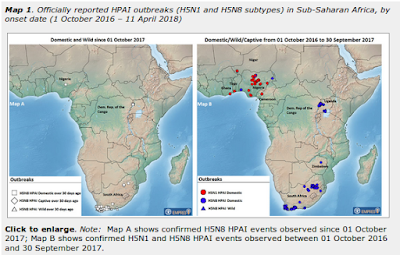 |
| Credit FAO |
#13,261
Even as the Northern Hemisphere's risk of HPAI diminishes with the approach of summer, African nations south of the Equator are bracing for what could be their second winter dealing with HPAI H5N8.
Additionally, equatorial Africa is at risk of AI year-round, although the number of reported outbreaks from West Central Africa have declined dramatically over the past year.The arrival of HPAI H5N8 - first to Zimbabwe and then South Africa - in the early summer of 2017 has led to hundreds of outbreaks in both commercial poultry and wild birds (including endangered South African Penguins).
While outbreaks in commercial poultry have been on the decline since late November, with winter now approaching, temperatures should be more conducive to the spread of the virus.As we saw with Europe this past winter, a second wave of H5N8 is far from gauranteed guaranteed. And Sub-Saharan Africa could even see the arrival of different reassorted virus - like HPAI H5N6 - this winter.
Given the fluid situation, the FAO will be issuing monthly updates over the coming months, with their latest posted today. I've only included some excerpts, so follow the link to read it in its entirety.
Sub-Saharan Africa HPAI situation update
11 April 2018, 17:00 hours; Rome
The next update will be issued on 09 May 2018
Disclaimer
Information provided herein is current as of the date of issue. Information added or changed since the last Sub-Saharan Africa HPAI situation update appears in red. For poultry cases with unknown onset dates, reporting dates were used instead. FAO compiles information communicated by field officers on the ground in affected countries, from regional offices, and from World Organisation for Animal Health [OIE], as well as peer-reviewed scientific articles. FAO makes every effort to ensure, but does not guarantee, accuracy, completeness or authenticity of the information. The designation employed and the presentation of material in the map do not imply the expression of any opinion whatsoever on the part of FAO concerning the legal or constitutional status of any country, territory or sea area, or concerning the delimitation of frontiers.
Overview
Situation: Highly pathogenic avian influenza virus (H5N1 and H5N8 subtypes) with pandemic potential in countries of Sub-Saharan Africa.
Confirmed countries (H5N1): Burkina Faso, Cameroon, Côte d’Ivoire, Ghana, Niger, Nigeria and Togo.
Confirmed countries (H5N8): Cameroon, Democratic Republic of the Congo, Niger, Nigeria, South Africa, Uganda and Zimbabwe.
Animal/environmental findings: Please see reports from individual countries below.
Number of human cases: None reported to date.
Situation update
South Africa H5N8 HPAI
(Continue . . . )
- Number of outbreaks* to date: 169
- Regions affected: Eastern Cape, Free State, Gauteng, Limpopo, Kwazulu-Natal, Mpumalanga, North West, Western Cape
- Outbreaks reported since last update: 5
- Most recent outbreaks: Observed on 11 March 2018 in North West Province